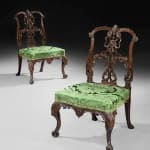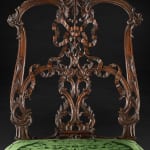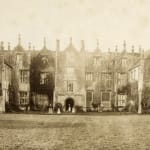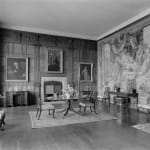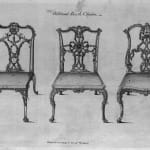A PAIR OF GEORGE II MAHOGANY RIBBON-BACK CHAIRS AFTER THE DESIGN BY THOMAS CHIPPENDALE
W: 29.25" / 74.3cm
D: 25.5" / 64.8cm
Further images
Provenance
Part of the set of eight most likely acquired by Thomas Harvard for Barrington Court, Somerset, c. 1756
Removed to Dillington House, Somerset, in the early nineteenth century
With R.L. Harrington, Ltd.
With Hotspur Ltd., London
Private Collection, London
Sold Christie's, London, 6 July 2023, lot 53, GBP 107,100
Private Collection: West Coast, USA
Exhibitions
Montacute House, Somerset, 1948-1979
Publications
A. Coleridge, Chippendale Furniture (London, 1968), figs. 173-5Nicholas Carew, `Montacute House, Somerset', Connoisseur Year Book (1952), p. 17, No. IX, the set of eight chairs in the dining room
G. Wills, English Furniture, 1760-1900 (London, 1971), p.18
N. Goodison and R. Kern, Hotspur: Eighty Years of Antique Dealing (London, 2004), pp. 136-7, fig. 8
J. L. Milne, Caves of Ice, Diaries: 1946 & 1947, pp. 127-8
L. Wood, ‘Tied Up In Knots: Three Centuries of the Ribbon-Back Chair,’ Furniture History (2015), vol. 51, pp. 241–70
‘We lunched at Judge Jeffrey’s house in Dorchester and at 2.30 reached Dillington Park, a delightful Tudor house, almost entirely rebuilt about 1810 in imitation of Barrington Court by Pennethorne. It has a cosy family-house air, most sympathetic. Present owner a young Mrs. Cameron. Her mother, Mrs. Vaughn-Lee, living with her. They offer us practically anything we like for Montacute, and E. and I selected straight away a number of things, including a fine set of ribbon-back eighteenth-century dining-room chairs.’ 1
James Lees-Milne is not the only one to have appreciated the oustanding quality of the present chairs. The ‘ribbon back’ chair, named for the elaborate fluttering ribbon motifs incorporated into the design, is one of the most recognised designs published in Chippendale’s pattern book, The Gentleman and Cabinet-Maker’s Director and is synonymous with his style.
In fact, so pleased was Chippendale with his designs in his first Director for ‘three Ribband-back Chairs’, on the third of which are the present chairs based, that he wrote in his commentary on the plate (XVI), ‘if I may speak without vanity’, they are ‘the best I have ever seen (or perhaps have ever been made)’.2
As Chippendale duly notes though - as he does throughout his Director - their ‘excellent effect’ depends on being ‘properly handled in execution’.3 The present chairs have certainly been carved by such a ‘skillful workman’, though Chippendale’s workshop is not necessarily their author. Closely related designs also feature on the trade cards of Chippendale’s contemporaries William Henshaw, cabinet-maker and upholsterer and subscriber to the Director, St Paul’s Church Yard (1754 - 73) and William Jellicoe, upholsterer, appraiser and undertaker of Fleet Street (1760 - 81), whom Lucy Wood suggests are likely candidates to have made the chairs.4
The chairs belong to a suite of eight that can be traced to Dillington House in Somerset (see above), which was acquired by the Hanning family in the early nineteenth century and ‘Gothicized’ by John Lee Lee (Hanning) (1802-74) in the 1830s. Lucy Wood suggests the suite was most likely acquired by John Lee Lee’s great-great-grandfather, Thomas Harvard, to furnish nearby Barrington Court, which he purchased in 1756.2 Barrington remained in the Hanning family but as Dillington became their primary residence, the chairs were likely moved there before Barrington was rented out and ultimately sold before 1858.5 Inventories of Dillington in 1874 and 1882 record ‘6 Carved Mahogany Antique Chairs’ in the Drawing Room, and ‘2 Carved Mahogany Chairs’ in the Dining Room, constituting the suite.
The suite remained at Dillington and passed by inheritance to Elizabeth Cameron (nee Vaughn-Lee). It was at this stage that they were loaned, with James Lees-Milne acting as intermediary, to the National Trust for Montacute House from 1948-1979, with an old loan inventory card recording them as a set of eight and a photograph capturing them in situ (see above).6
Hotspur later acquired six from the suite and sold them in pairs. One pair entered the collection of S. Jon Gerstenfeld, Washington D. C. (sold Christie’s London, 7 July 1988, lot 77, GBP £82,500) and was subsequently in the collection of Ann and Gordon Getty (sold Christie’s New York, 23 October 2022, lot 554, USD $214,200). A second pair is now in the Indianapolis Museum of Arts [81.375, 81.376]. The third is offered here.
1 J. L. Milne, Caves of Ice, Diaries: 1946 & 1947 (Trowbridge, 1983), pp. 127-8
2 Thomas Chippendale, The Gentleman and Cabinet-Maker’s Director (London, 1754), p. 8
3 Idem.
4 L. Wood, ‘Tied Up In Knots: Three Centuries of the Ribbon-Back Chair,’ Furniture History (2015), vol. 51, pp. 241-3
5 Ibid., pp.
6 A. Baggs & R. Bush, A History of the County of Somerset, v. 4 (London, 1978), pp. 113-121; Arthur Oswald, ‘Montacute Re-visited—II’, Country Life, 27 October 1955, p. 962, fig. 6





